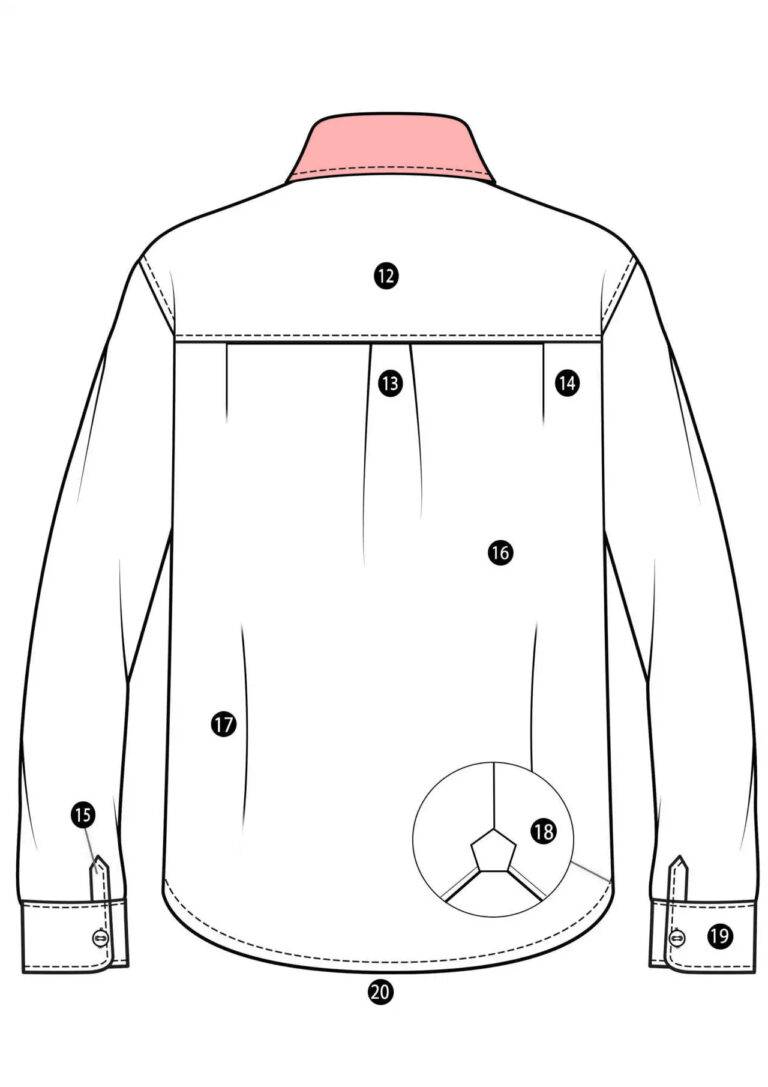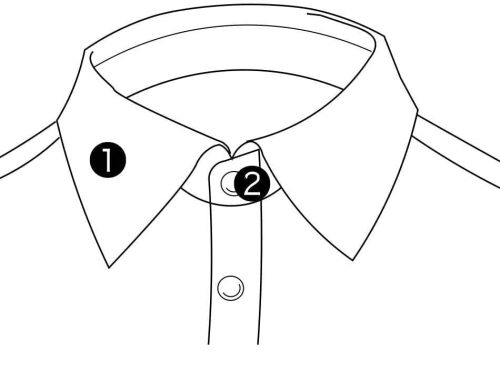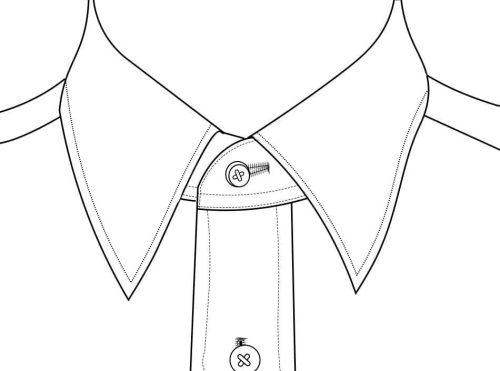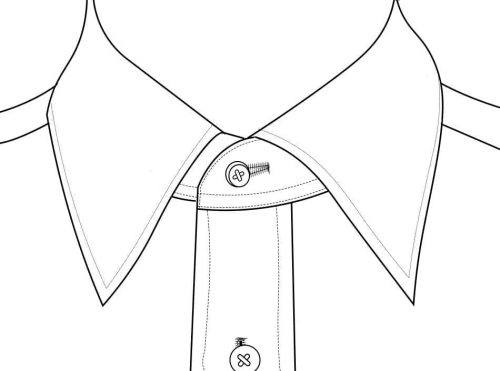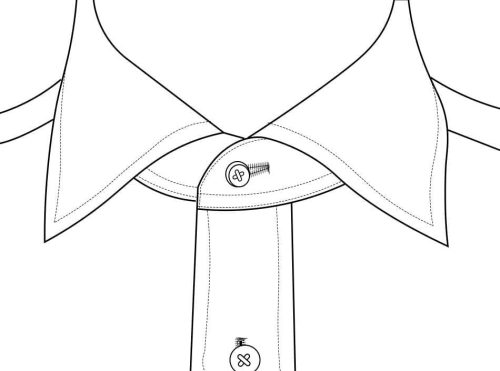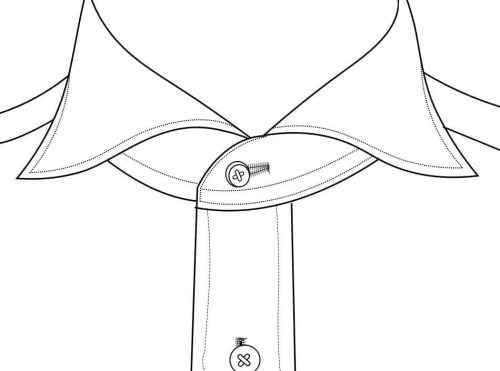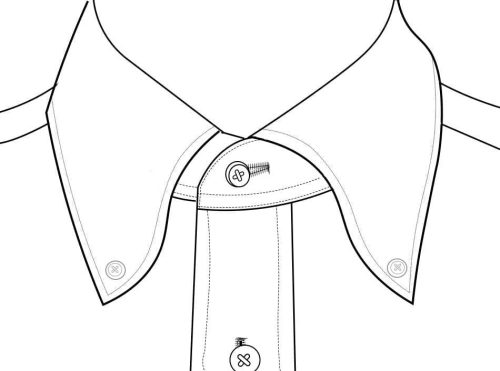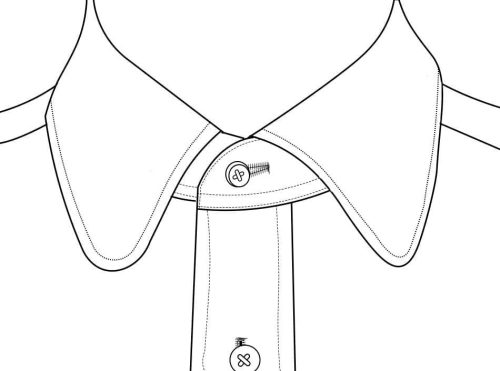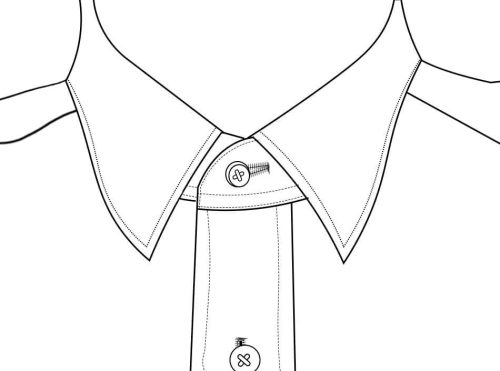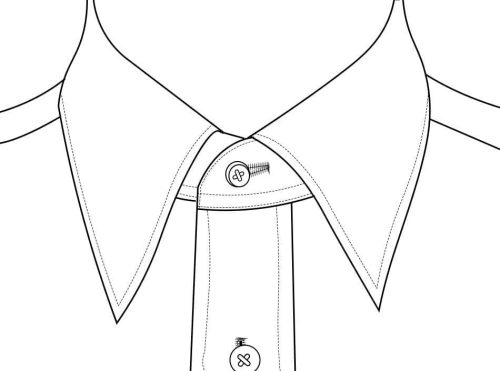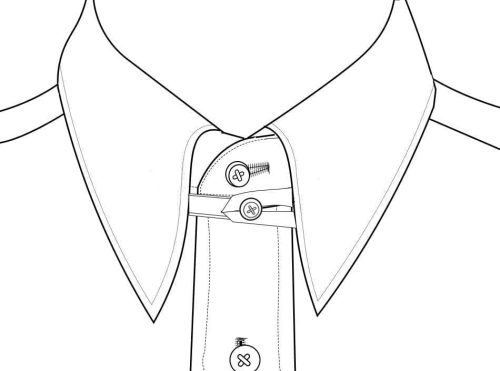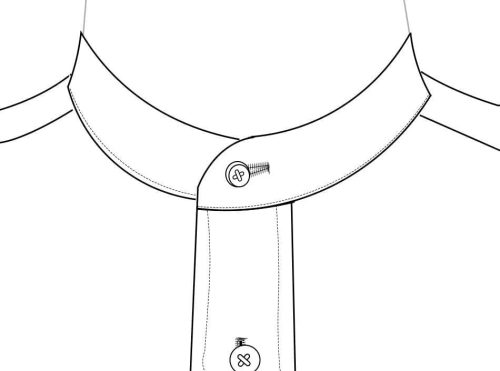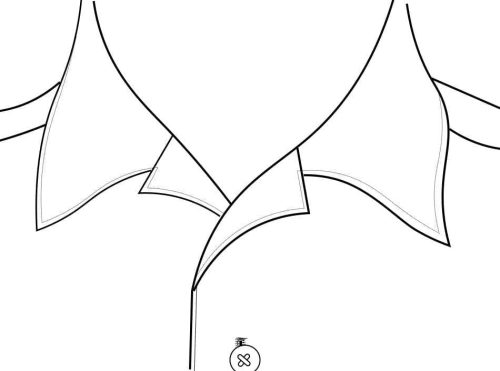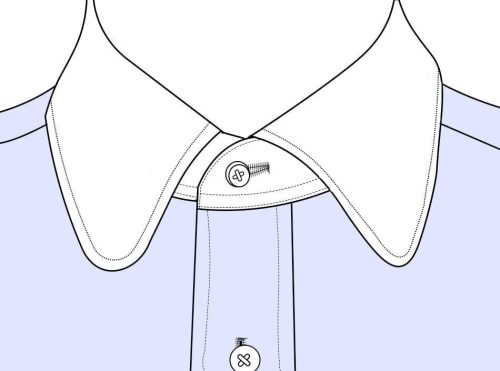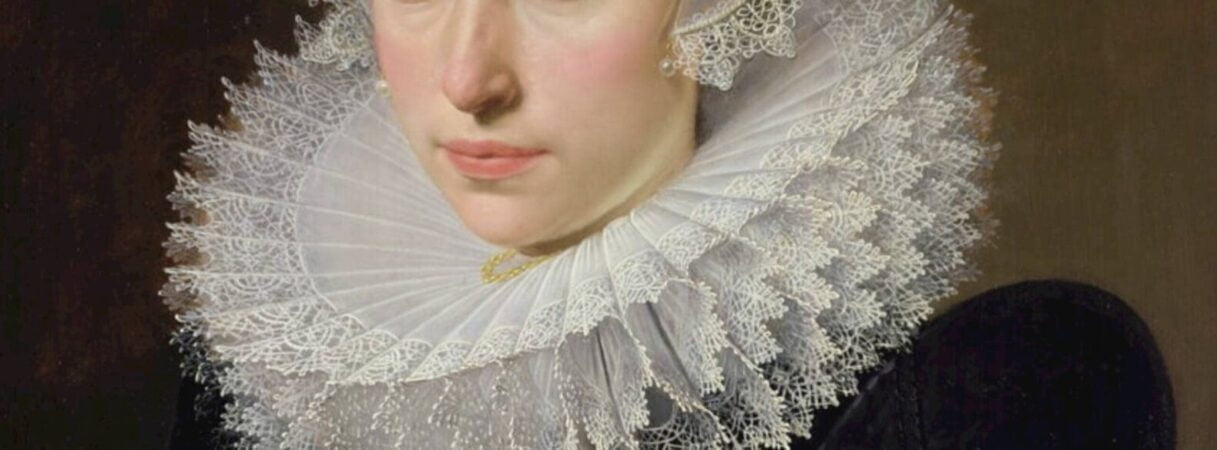The shirt collar, despite its small size, embodies the fusion of fashion and functionality with two crucial parts hidden within: the “collar” and the “collar stand ” While seemingly simple in structure, these two parts play distinct roles.The collar is the part that folds out from the neck, determining the shirt’s style and atmosphere. Meanwhile, the collar stand, hidden beneath the collar, maintains its shape and ensures a proper fit around the neck.
The combination of these parts determines the shirt’s comfort and impression. If the collar creates the shirt’s expression, the collar stand is the skeleton that maintains it. Only when these two parts harmonize does the shirt truly express the wearer’s individuality and excel in functionality.Thus, the shirt collar, despite its small size, showcases an ingenious structure that perfectly balances fashion and functionality. Understanding its depth offers a new perspective on the value of a shirt.
シャツのカラーは、その小さな形状の中に、ファッションと機能性の融合を体現する二つの重要なパーツを秘めています。それは「襟」と「台襟」です。一見単純な構造に見えるかもしれませんが、この二つの部分は異なる役割を担っています。襟は首から外側に折り返された部分で、シャツのスタイルと雰囲気を決定づけます。一方、襟の下に隠れた台襟は、襟の形状を維持し、首にフィットさせる役割を果たします。この襟と台襟の組み合わせが、シャツの着心地と印象を決定づけているのです。襟がシャツの表情を作るなら、台襟はその表情を保つ骨格のようなものです。二つのパーツが調和して初めて、シャツは着る人の個性を表現し、機能的にも優れた一着となるのです。このように、シャツのカラーは小さな部分ながら、ファッションと機能性の絶妙なバランスを示す巧みな構造を持っています。その奥深さを理解することは、シャツの価値を新たな視点から見直すことにもなるのです。
The Regular Collar is a standard option suitable for both business and casual wear. It features a moderate height and width, with the angle between the collar points typically around 75-90 degrees.
レギュラーカラーはビジネスやカジュアルのどちらにも適した標準的な襟です。適度な高さと幅を持ち襟先の角度は通常70〜90度です。
The Semi-Wide Collar strikes a balance between a regular collar and a wide spread collar, making it versatile for both business and semi-formal settings. The angle between the collar points is usually around 100-120 degrees
セミワイドカラーは、レギュラーカラーとワイドスプレッドカラーの中間の広がりを持ち、ビジネスやセミフォーマルな場面に適したバランスの取れたデザインです。襟先の角度は通常100〜120度です。
The Wide Spread Collar offers a modern and elegant look, ideal for formal occasions as it accommodates larger tie knots. The angle between the collar points is generally around 120-140 degrees.
ワイドスプレッドカラーは、モダンでエレガントな印象を与え、フォーマルな場面に適しています。大きなネクタイノットにも対応でき、襟先の角度は一般的に120〜140度です。
Horizontal / CUTAWAY Collar
The Horizontal Collar, also known as a horizontal spread or cutaway collar, features a very wide spread that is almost horizontal, providing a sharp and modern appearance. This collar is suitable for large tie knots or no tie at all, with the angle between the collar points being approximately 150-180 degrees.
ホリゾンタルカラー(またはカッタウェイカラー)は、ほぼ水平に広がる非常に広い襟を特徴とし、シャープでモダンな印象を与えます。この襟は、大きなネクタイノットやノーネクタイのスタイルに適しており、襟先の角度は約150〜180度です。
The Button Down Collar has its origins in late 19th-century England, where polo players sought a way to keep their collars from flapping in their faces during matches. They came up with the idea of fastening the collar points with buttons. This practical design was adopted by the American fashion brand Brooks Brothers, who introduced the button-down collar shirt to the broader public in 1896.
ボタンダウンカラーの起源は、19世紀末のイギリスのポロ選手に遡ります。ポロ選手たちは、試合中に襟が顔に当たらないようにするために、襟の先端をボタンで固定する方法を考案しました。この実用的なデザインは、アメリカの著名なファッションブランドであるブルックス・ブラザーズによって取り入れられ、一般的に普及しました
Hidden Button Down Collar
The Hidden Button Down Collar is a variation of the button-down collar where the buttons that secure the collar points are hidden underneath the collar fabric. This design maintains the neat, orderly appearance of a button-down collar but with a cleaner, more streamlined look, as the buttons are not visible. The hidden button-down collar is ideal for maintaining a crisp look without the casual connotation of visible buttons. It is suitable for both formal and business casual settings, providing the benefits of a traditional button-down collar (keeping the collar points in place) while offering a more polished aesthetic.
ヒドゥンボタンダウンカラーは、ボタンダウンカラーの一種で、襟先を固定するボタンが襟の生地の下に隠れているデザインです。このデザインは、ボタンダウンカラーのきちんとした整った外観を保ちながら、ボタンが見えないため、より洗練されたクリーンな見た目を提供します。ヒドゥンボタンダウンカラーは、フォーマルやビジネスカジュアルな場面に適しており、従来のボタンダウンカラーの利点(襟先を固定する)を提供しつつ、より洗練された美学を持っています。
Club Collar / ROUND COLLAR
The Club Collar features rounded collar tips. This style gives a retro and classical impression. Originally popular in late 19th-century English clubs, it later gained popularity in the United States. Today, it is often used in both casual and semi-formal settings.
クラブカラーは、襟の先端が丸くカットされたデザインです。このスタイルは、レトロでクラシカルな印象を与えます。元々は19世紀末のイギリスのクラブで人気があり、後にアメリカでも流行しました。現在もカジュアルからセミフォーマルな場面で使用されることが多いです。
Tab Collar features a tab in the middle of the collar that can be fastened with a button. This tab lifts and secures the tie knot, maintaining a neat and elegant shape. This design is suitable for formal occasions and provides a classic, refined appearance.
タブカラーは、襟の中央にタブが付いており、このタブがボタンで留められるようになっています。タブはネクタイの結び目を持ち上げて固定し、美しい形を保ちます。このデザインはフォーマルな場面に適しており、クラシックで洗練された印象を与えます。
This collar features small holes near the points for a collar bar or pin, which lifts the tie knot and secures it. It’s ideal for a polished and classic look.
襟の中央にピンを通す穴があり、ネクタイを持ち上げて固定するデザインです。クラシックでエレガントなスタイルに適しています。
The tips of the collar stand up and fold over, often seen in tuxedo shirts. It’s typically worn with bow ties for formal events.
襟先が小さく折り返されたデザインで、タキシードシャツなどフォーマルな場面で使用されます。ボウタイと組み合わせることが多いです。
Stand Collar / band collar / Mandarin Collar
A stand collar is a simple and elegant design where the collar stands up without a fold, suitable for a range of styles from casual to semi-formal, providing a modern look without the need for a tie, making it an ideal choice for those seeking versatile fashion options.
スタンドカラーは、襟が立ち上がり折り返しがないシンプルでエレガントなデザインの襟で、カジュアルからセミフォーマルまで幅広く使用でき、ネクタイを必要とせず快適でモダンな印象を与えるため、ファッションの多様性を追求する人にとって理想的な選択肢です。
The open collar shirt is a casual shirt with a collar that lies flat and open, typically without buttons, giving a relaxed look. Made from lightweight materials like linen or cotton, it is ideal for summer and resort wear. It can be worn casually with jeans or shorts or layered over a T-shirt for a stylish look.
オープンカラーシャツ(Open Collar Shirt)は、襟が開いたデザインで、ボタンがなくリラックスした印象を与えるカジュアルなシャツです。主にリネンやコットンなどの軽量素材で作られ、夏場やリゾート地での着用に適しています。ジーンズやショートパンツと合わせてカジュアルに着こなしたり、Tシャツの上に羽織ってレイヤードスタイルを楽しむことができます。
(White) Contrast Collar / Cleric Collar
The White Contrast Collar, a term of Japanese origin, refers to a style where the collar and cuffs are made from a different color or fabric than the rest of the shirt. Typically, the collar and cuffs are white, creating a sharp contrast with the body of the shirt, which is in a different color or pattern. This design originated from the shirts worn by clerics in 19th-century England, hence the name “cleric.” Today, it is widely used in business and semi-formal settings, providing a formal and sophisticated appearance.
クレリックカラーは和製英語で、英語では「White Contrast Collar」と呼ばれます。このスタイルは、襟とカフスがシャツの他の部分と異なる色や生地で作られているシャツを指します。一般的には白い襟とカフスが、異なる色や柄のシャツ本体と組み合わされ、鮮やかな対比を生み出します。
このデザインは、19世紀のイギリスの聖職者(クレリック)が着用したことからその名が付けられましたが、現在ではビジネスやセミフォーマルな場面でも広く使用され、フォーマルで洗練された印象を与えます。


